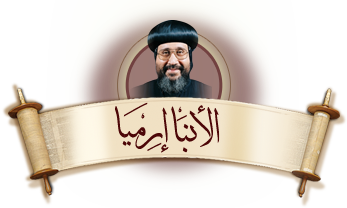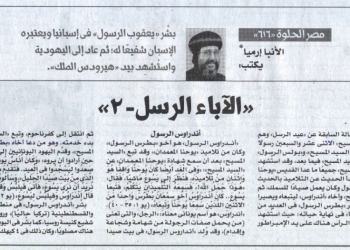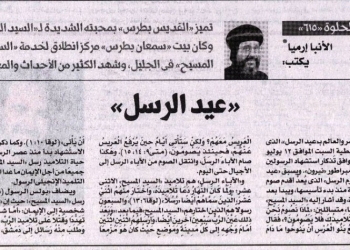Today, Eastern Christians celebrate Easter which is one of the important Christian feasts. This feast has several names, such as, Easter, Easter Sunday, Resurrection Day, and Passover. Passover derives from “pass” which means “crossing”.
Setting the Feast Time
Jews celebrate Passover on Nissan 14, whereas Christians celebrate Christ’s Resurrection on the following Sunday of the Jewish Passover, as per the decree of the Nicaea Council in 325.
The Pope of Alexandria was in charge of setting the Passover, as the Church of Alexandria was famous for her adeptness in astrology. He used to let other bishops know of this date in a message known as “Passover Epistle”.
The Church of Alexandria laid the “apokty”, an astrological calculation, in the thirteenth century, during the tenure of Pope Demetrius the vine-collector (the twelfth patriarch). Easter is set according to this calculation. Churches in the four corners of the world used to abide by it until 1528. To celebrate Easter, the following was strictly considered: it should be a Sunday (to coincide with Christ’s Resurrection), it should succeed the Jewish Passover and the beginning of Spring. In 1528, the Western Church started following the Gregorian calendar. This year, however, both celebrations coincide. Sometimes, the Western Easter comes a bit earlier.
Celebrating Easter
We get ready for Easter by fasting for a long time that ends in the Passion Week which ends with Easter. Celebration starts on Apocalypse Saturday Eve to culminate in the prayers of Sunday dawn, commemorating Christ’s Resurrection at dawn: “Now when Jesus was risen early the first day of the week…”
Western Easter
In like manner Christmas and New Year Eve are linked with Santa Claus, Western Easter is linked with eggs and bunnies!
In Europe, the bunny used to symbolize the god of fertility which was celebrated at the beginning of Spring. Due to the fact that Easter coincides with Spring, the symbol was adapted by Western Christians, then by the Americans.
The bunny continued to be used in Germany until it moved to America by the end of the Civil War. It was thought the bunny used to bring colored eggs with him at the beginning of Easter celebration. He would hide them in the house. Then onward, this legend became a custom followed by households whereby a bunny, as well as a basket of colored eggs, would be placed in every house.
Eastern Celebrations
In the East, we celebrate Easter by linking eggs to Resurrection: for they connote that in like manner life comes from within the egg which is tightly closed, the chick penetrates it with its own strength, Christ rises from the dead.
The Link between Easter and Sham al-Nessim
Ancient Egyptians used to celebrate Sham al-Nessim at the beginning of Spring, calling it, “the coming forth feast”. The word “Sham al-Nessim” derives from the Coptic Language. It means, “orchard”. Sham al-Nessim used to start with religious rituals, followed by public celebrations in which Egyptians of all classes participated. They used to go parks and fields to spend the day celebrating the coming forth with the advent of Spring.
After Christianity had spread in Egypt, they found out that this celebration takes place during Great Lent. So, its time was changed to the day that succeeds Easter. This day has become a public feast which all Egyptians celebrate.
Among the traditional food of Sham al-Nessim, we find eggs, salted fish, onions, lettuce, and green cicer.
As for fish, ancient Christians used to eat them grilled, in like manner Christ ate them with his disciples at Lake Tiberias after Resurrection. Some maintain that during the epochs of persecution, fish was prohibited lest Christians eat it on that day. In effect, they would salt them before Sham al-Nessim to eat it then! They never stopped doing so until after the persecution had stopped.
Also, fish is salted lest it rot. This is a symbol of Christ whose body remained sound. As for onions, they grow when buried in the soil, sprouting green branches.
One of the beautiful stories linking Easter to eggs is that of Jimmy who was born mentally and physically disabled. Though he was twelve, he was still in the primary school. He had twenty colleagues. Due to his condition, he used to disturb his teachers and classmates for he was noisy and restless. Yet, he was articulate.
Despite the fact that he could hardly think or concentrate, he understood certain things as if his disabled mind was suddenly illumined!
One day, a teacher started discussing Jimmy’s issue with his parents. She suggested that he be transferred to a specialized school, for it was hard to continue having him with his colleagues due to the huge gap between him and them. How harsh these words were for the parents! The mother wept, whereas the father said it was hard to carry out the suggestion, as there was no school nearby. Also, transferring Jimmy to another school would shock him as he loved his teacher and colleagues exceedingly.
The teacher could not do anything but bear this disabled child, with two conflicting emotions within her. She could not bear his presence and behavior. At the same time, she cannot resist her conscience as a teacher: It was not Jimmy’s fault. Finally, she decided to give him another chance. She started doing her best to ignore his behavior; yet, she felt she could not make it. Then, it came to pass that Jimmy approached her and told her he loved her, which amazed her and the children. So, she thanked him and asked him to sit down.
By the beginning of Spring and Easter celebrations, the teacher recounted the story of Easter to her pupils. Then, she gave each one a plastic egg and asked them to bring it on the following day after putting something symbolic of life inside it.
While talking, she looked at Jimmy and wondered if he got the story and what she asked. On the following day, the pupils came over, and each put the egg in a box on the teacher’s desk. She started opening each egg to see what was expressive of life. In the first, she found a flower sprouting from buried seeds. In the second, she found a butterfly coming out of a cocoon… and so on. Then, she opened an egg and found nothing. She realized it was Jimmy’s. So, she thought he did not understand her request.
The teacher put it aside lest she embarrass him. While looking for another egg, she heard Jimmy asking her, “Why didn’t you explain the meaning of the egg I brought?” “There is nothing inside it, Jimmy,” replied she.
“Yes, it stands for Christ’s empty tomb,” said Jimmy. The teacher asked, “Do you know why it was empty?” He answered, “Because He is risen.” Here, the recreation bell rang, but the teacher started contemplating Jimmy’s words.
Three months later…
Jimmy died! Whoever went to visit his tomb found nineteen eggs which his colleagues carefully placed on it. All of them were empty, alluding that Jimmy will rise to eternal life.
The Resurrection in which all religions believe is a great message. Every man should know his life is an endless journey. It starts with his birth to be continued in heaven.
In effect, he has to do good deeds, be kind, loving, merciful, and benevolent to whoever he encounters throughout his life. At resurrection, he will find all the good he had offered.
Many happy returns on Easter and Sham al-Nessim! We beseech God to fill Egyptians’ hearts with happiness, and Egypt with safety and prosperity. Stories will never end in Beautiful Egypt.
General Bishop
Head of the Coptic Orthodox Cultural Center


 العربية
العربية











